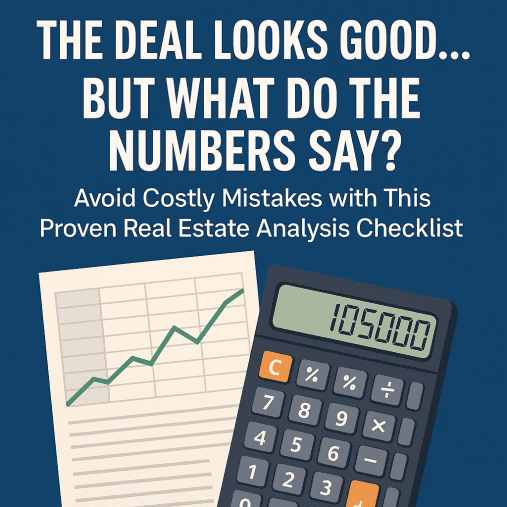
A Proven Checklist for Smarter Real Estate Investment Analysis
⸻
You’ve seen the listing. It’s in a “hot” area, the agent says it “won’t last,” and the rent roll looks appealing. But before you take out your pen, or even think about negotiating, there’s one essential question:
Do the numbers really work?
In real estate investing, numbers are everything. A property that looks good can quickly descend into a cash flow disaster if you don’t analyze it carefully — and with the right tools.
That’s why we created this checklist — based on decades of working with income property investors, developers, and brokers — to help you avoid some of the most common (and costly) mistakes.
⸻
🏘️ Step 1: Know What You’re Buying
It all starts with good data (or dare we say real data?). Don’t rely on estimates or vague projections or presentations based on what they coulda-woulda-shoulda be getting that rent. Ask to see the rent roll, tax bills, insurance records, and leases — and even ask for the property’s income tax return or Schedule E. Make sure you understand what the current income is and where there might be hidden liabilities or upside.
Your goal here:
•Verify that the revenue and expenses you’ve been shown are real and recurring — not wishful thinking.
•Spot vacancies, concessions, or tenant risks early. Look for lurking capital costs, like HVAC system or roof replacement.
•Confirm any secondary revenue streams like parking, laundry, vending.
⸻
💸 Step 2: Normalize and Analyze Income and Expenses
Once you have the raw data, you need to normalize it. That means stripping out one-time costs or revenue, owner perks (like cell phone bills), and unrealistic projections.
On the expense side:
•Are property taxes up to date and based on current valuation? No special allowance or abatement for the current owner?
•Are utilities and maintenance costs in line with similar properties?
•Is property management cost factored in, even if self-managed today?
Use this information to determine the Net Operating Income (NOI) — a key metric that drives everything from valuation to debt coverage.
⸻
📉 Step 3: Model Financing and Project Cash Flow
Even a property with strong NOI might not work with poor financing. You’ll want to model:
•Proposed mortgage terms: interest rate, term, loan-to-value, balloon structure
•Monthly and annual debt service
•Debt Service Coverage Ratio (DSCR) — ideally above 1.25
•Long-term cash flow, including reserves for replacements and capital improvements
Don’t forget to make long-term projections to test how cash flow holds up if interest rates rise, vacancy increases, or rents stagnate.
⸻
📈 Step 4: Evaluate Return and Risk
Now you’re ready to look at performance metrics:
•Cap Rate: Does it match market comps? Is it high because of risk?
•Cash Flow: Is it positive from the get-go? Is it likely to stay positive if you encounter headwinds?
•Equity Multiple: Understand your total payback on invested capital over the life of the investment.
•IRR (Internal Rate of Return): What’s your return over time — and is it worth the risk?
Experienced investors model multiple scenarios — a rent growth case, a lease-up delay case, or a sale at a less favorable cap rate — to test the strength of the deal under pressure.
⸻
🏁 Step 5: Plan Your Exit
Every good investment starts with the end in mind.
Estimate resale value based on projected NOI and conservative cap rates. Include selling costs, mortgage payoffs, and taxes, which will reduce your net cash at sale. Ask:
•If the market dips, does your return still make sense?
•Have you tested different sale years? Is the timing of your sale optimal, coinciding with peak IRR?
⸻
📘 A Step Beyond:
Cap Rate, Equity Multiple, and IRR are important — but keep in mind they’re not the only arrows that might fit in your analytical quiver.
Maybe that’s why my book is called What Every Real Estate Investor Needs to Know About Cash Flow… And 36 Other Key Financial Measures.
⸻
🧠 Final Thought: Numbers First, Emotions Second
At RealData, we’ve seen many, many deals over the years — and the ones that succeed all have one thing in common: rigorous, clear-eyed analysis upfront.
Whether you’re buying your first duplex or a multi-million-dollar shopping center, take the time to ask:
“Do the numbers work?”
When you do, you’ll invest with clarity and confidence.
⸻
🛠 Want to Run the Numbers Faster?
Our REIA Express and REIA Pro software tools were built specifically to help real estate investors like you model deals with precision — and avoid surprises later.
👉 Explore the software tools we recommend
👉 Watch a short video
👉Transform your financial future with expert on-demand training — and earn a certificate
⸻
📬 Want the full checklist in printable format?
👉 Click here to download a PDF version you can use on your next deal
The information presented in this article represents the opinions of the author and does not necessarily reflect the opinions of RealData® Inc. The material contained in articles that appear on realdata.com is not intended to provide legal, tax or other professional advice or to substitute for proper professional advice and/or due diligence. We urge you to consult an attorney, CPA or other appropriate professional before taking any action in regard to matters discussed in any article or posting. The posting of any article and of any link back to the author and/or the author’s company does not constitute an endorsement or recommendation of the author’s products or services.
Mastering Real Estate Investing
Learn how real estate developers and rehabbers evaluate potential projects. Real estate expert Frank Gallinelli — Ivy-League professor, best-selling author, and founder of RealData Software — teaches in-depth video courses, where you’ll develop the skills and confidence to evaluate investment property opportunities for maximum profit.